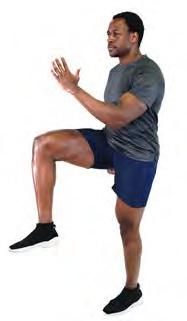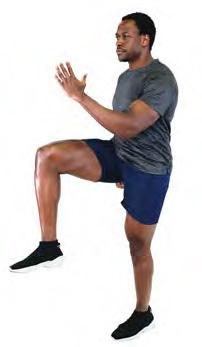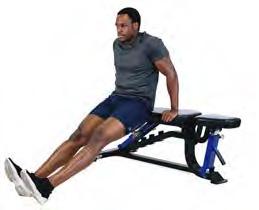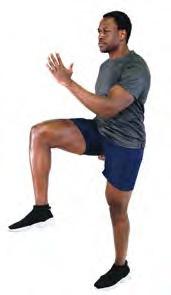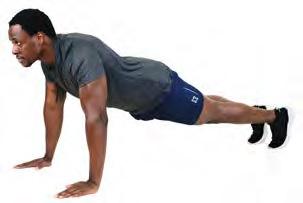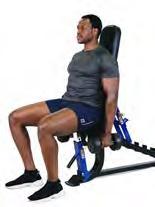

FITTER. HEALTHIER. HAPPIER.
As one of South Africa’s most successful weight-loss programmes, the USN Body Makeover Challenge has transformed thousands of people’s bodies and lives over the years.

This 12-week challenge comes with three healthy eating plans that have specifically been developed by a dietician, accompanied by a supplement plan for the best results. The exercise plans are divided into three stages, guiding you step-by-step on your weight-loss journey.
THE PROGRAMME CONSISTS OF THE FOLLOWING:
• Eating plans
• Supplement plans • Training plans
• A personal dashboard
Share your journey with us by following our social media pages, tagging us in your posts and using our hashtags.
Our social media pages make it possible to connect with like-minded individuals who are on the same journey.

Facebook: USN Body Makeover
Instagram: @bodymakeoversa
WHAT YOU NEED TO BE SUCCESSFUL
SET GOALS
Setting small short-term goals and celebrating them when you reach them is crucial. These short-term goals should be used as progress markers to achieve your ultimate fitness goals.

PLANNING
Planning is essential to a weight-loss journey and can make life considerably easier. Simple things like meal preparations and buying the right groceries go a long way to support you in your journey.
Supplements are there to support your weight-loss goals. Using supplements will help you on your journey and accelerate and maximise the results of your hard work and dedication.
ADHERENCE
Adherence and commitment to the eating and exercise plans are essential, as these plans were specifically designed to deliver optimal results.
SELF-DISCIPLINE
Certain things will have to be restricted, while others will have to be increased in your day-to-day life to lose weight successfully. A well-balanced eating plan alongside an adequately designed training regime is vital. You will still have to gather the self-discipline to implement these plans and follow them well.
SUPPORT

Get the support of people who you love and trust. Their involvement will ultimately keep you accountable and carry you through the times when the challenge gets tough.
STRUCTURE
Get used to the structure of the 12-week challenge by planning your days around it and using the resources provided for the challenge. Make sure you understand how the training plan works and that you are comfortable with everything on the eating plan.
TIME MANAGEMENT
You need to manage your day to ensure you make time for exercise and to get the necessary rest for recovery. Lousy time management also leads to people grabbing the nearest convenience foods. It can also lead to feeling pressured and overwhelmed.
COMPLETE GUIDE ON

NUTRITION
This guide will help you to understand food and nutrition better and to build habits that encourage a healthier and sustainable lifestyle.
UNDERSTANDING NUTRITION
During the next 12 weeks, you will learn to choose the right foods, what foods work better for your body, and how to prepare healthy meals while still enjoying your food.
You cannot underestimate the importance of good nutrition and sound dietary habits. Improving your basic knowledge of nutrition is perhaps the most critical part of your Body Makeover Challenge journey. This will have a positive impact on your ability to stick to the food options, and it will help you to select good food preparation methods.

MACRONUTRIENTS
Macronutrients are the nutrients the body needs in large amounts to function optimally. These nutrients include carbohydrates, fat and protein.
CARBOHYDRATES
Carbohydrates are broken down into individual glucose, fructose or galactose molecules through the digestion process. Glucose is your body’s preferred energy source as it is rapidly utilised during exercise. Your body can store excess glucose in the form of glycogen to ensure there are always energy reserves. If you do not consume enough carbohydrates, your body can get glucose from glycogen stores or muscle tissue by breaking down the protein. On the other hand, if you take excessive quantities of carbohydrates and your glycogen stores are full, your body stores the rest of this energy in the fat cells.

FAT
During digestion, fat is broken down into smaller fatty acids and then transported to the rest of the body to provide lipids to the cells. The primary function of fat is to provide energy. In addition to that, fat also forms part of cell membranes and provides you with fat-soluble vitamins. Maintaining good brain, nervous and endocrine health all rely on fatty acids being made available through your diet.

PROTEIN
Protein is made up of small amino acids that are bound together. Protein plays a role wherever the body is growing, repairing or replacing tissues. It specifically supports lean muscle tissue growth by using amino acids to build tissue. Protein also plays a vital role in specific components of your immune system, hormones, nervous system, and organs. Your body can also break down protein to provide energy and glucose when it does not have enough energy
HOW TO MANAGE ENERGY INTAKE?
HOW DOES ENERGY WORK?
Your body needs energy and nutrients to thrive. All foods hold a certain amount of energy depending on the amount of protein, fat and carbohydrates it contains. Weight loss is all about managing your energy intake and expenditure. Ideally, your goal should be to balance your energy intake and expenditure to fuel your body properly and manage your weight simultaneously.
If you consume too much energy or expend too little energy, your body can store the excess energy it is not using as fat. So if you want to lose weight, you need to consume less energy and expend more energy to dig into the fat stores.
CHOOSE THE RIGHT TYPES OF FOOD
When you are trying to lose weight, food choices are everything. The more processed and refined a food option is, the less fibre and nutrients it usually contains. Try to limit processed foods as far as possible. Choosing the right foods will help you consume the right amounts. For example:

3 ½ cups = 190 calories
1 small packet = 190 calories
3 ½ cups of broccoli is larger in volume and contains more fibre so it will fill you better compared to a small packet of crisps.



From this example it is easy to see how the right food choices can help.

PREPARE YOUR FOOD THE HEALTHY WAY
How you prepare food can unknowingly add a lot of calories to your meals. Rather steam and grill foods than shallow-frying and deep-frying them.
Sauces, dressings and condiments add large amounts of calories to an otherwise healthy meal; they should be avoided as far as possible.
Sticking to our recommended foods and menu options will keep you on track without complicating the process.
SO WHAT SHOULD YOU EAT?
The food you need to eat depends on the meal plan that you are following, but there are a few basic principles that apply to all meal plans.
We’re making it easy for you to select healthy choices from various foods. Dieticians have specifically developed our eating plans to ensure that you limit ‘empty’ calories while maximising the nutrient density in your meal plans. Select your food with a focus on variety.

For optimum nutrition, eat more lean proteins, fresh vegetables, salad greens and healthy fats to support your immune system and ensure good health.
Diet, low-calorie and zero-sugar beverages are allowed to be consumed in moderation during your Body Makeover Challenge.
Water is preferred as it contains no calories, preservatives or additives. It also assists with hydration, metabolism, recovery and waste removal. You can add sliced fruits or freshly squeezed lemon juice to add flavour variety and zest.

Avoid all fruit juices as these contain more calories. You may consume 2 to 3 cups of coffee/tea a day and use Xylitol as a substitute for sugar, which is widely available in retail stores.
Low calorie | zero sugar | diet beverages
When it comes to fat, quality is essential. Primarily include unsaturated fats in your diet, as these can benefit cardiovascular health. Unsaturated fats include extra virgin olive oil, MCT oil, fatty fish, nuts, seeds and avocado. Animal fats can benefit human health, particularly on a cellular and hormonal level; however, you should consume these fats in the correct amounts. Avoid processed fats (hydrogenated oils and trans fats).
Vegetables are full of vitamins, minerals and antioxidants, and they provide high fibre levels. Colour and crunch are important; vegetables that are deep green, orange or red contain the most vitamins, minerals and health-promoting phytochemical levels.

Vitamins | minerals | antioxidants
Proteins can come from both plant and animal sources, and it remains an essential component of your eating plan. Choose a variety of protein options using the exchange list of your eating plan. It is vital to meet your protein requirements.

Plant sources | animal sources


ADAPTATION
WEEK1 ‒4
Do not pay too much attention to the scale or measurements at this point. There is a possibility that you will not lose any weight or centimetres in your first two weeks. Do not let this demotivate you, as it is normal. Your body needs to adapt, and it isn't easy to do everything correctly from the start.
WHAT TO EXPECT IN THIS PHASE
STIFFNESS & SORENESS
Being stiff and sore is normal as your body adapts to the new training plan. Stiffness and soreness are caused by lactic acid build-up in your muscles and microscopic tears in your muscles caused by exercise.

Our recommended supplements can assist with faster recovery and reduced soreness.
FATIGUE
Being tired is a natural phase as your body adapts to a calorie-restricted eating plan and new training programme. You will, however, start experiencing more energy, vigour and alertness as time progresses.
SLOW WEIGHT LOSS
You may lose little weight in the first two weeks as your body is still adapting, but you will progressively lose fat and retained fluids. It is normal for your body to show little signs of weight loss during this phase as your metabolism starts to speed up and your body starts to utilise its energy sources more efficiently.
POSSIBLE WEIGHT GAIN
In the first two weeks, you may experience inflammation in your sore muscles, increasing the weight shown on the scale.
PROGRESSION
WEEK5 ‒8
This phase is focused on taking your training to the next level and accelerating the effects experienced in Phase 1. This phase requires more self-discipline and stronger adherence to the training plan. It is essential to focus on completing the training according to the plan. Increased intensity, decreased rest and increased workload are critical in this phase as we are trying to accelerate weight loss and increase lean muscle.
WHAT TO EXPECT IN THIS PHASE
FEELING FIT & MOTIVATED
You will begin to experience the benefits of getting fitter you will be able to climb stairs easier, walk further without strain and perform better for longer while training.
DECREASED FATIGUE
During this phase, you should experience less fatigue as your body is used to the eating and training plans. You should be able to fit your training into your normal day without taking too much of a toll on you.
SLIGHT SORENESS & STIFFNESS
You might experience a degree of soreness and stiffness again due to the increased intensity of the programme, which should subside within a week.


INCREASED HUNGER
You may experience more cravings and hunger than during phase 1. This is due to the increased intensity that burns energy faster.
Do not deviate from your eating plan, as this phase will demand more from your body. Sticking to the plan will accelerate your fat loss.
INCREASED MOTIVATION
By this point, you already know that you can make it through this challenge and have already seen some results. Let this motivate you to pick up your intensity and commitment during Phase 3.
MA XIMISAT & INTEGRATION
WEEK9 ‒ 12
There are two important things to focus on in the final four weeks of the challenge: maximising your results and integrating the challenge into your daily life.
The final phase will focus on pushing you to the highest level of the challenge. The training plan will become even more intense, and this is needed to break through the plateau created by phase 2. This is your last phase before you complete the challenge; make it count.
WHAT TO EXPECT IN THIS PHASE
LIFESTYLE CHANGE
After dedicating three months of your life to this challenge, you will struggle to remember how you did things before. The challenge will become part of your lifestyle, as you are now more educated to make better choices for the future.
INCREASED FATIGUE
You may experience more fatigue during the first two weeks of phase 3 as your body adapts to the increased intensity. Keep using your supplements and ensure you get enough rest.
INCREASED HUNGER
You will demand even more of your body in the coming weeks. Make sure you have the right supplements to support you during the remainder of the Body Makeover Challenge.
SIGNIFICANTLY INCREASED TRAINING LOAD
This phase will require that you give even more during training, and it will push you to your limits and leave little chance for rest. You have never been in a better physical condition to challenge your body in a way that will make a lasting impact. Completing the final phase of the challenge will also give you an inherent mental victory over your old self.
INCREASED STRENGTH, FITNESS & ENDURANCE LEVELS

By this phase of the challenge, you should already see significant changes in your fitness levels and lean muscle mass. This is an excellent time to reflect on yourself from week 1, and let this motivate you to finish strong.

MEASUREMENTS


Measure the circumference around the largest point on your upper arm above the elbow, with your arms relaxed by your side.
Measure the circumference around your chest or bust and your back, at the end of an exhale. Measure tape should be under the armpits, around your shoulder blades, and close to the nipple line.
Measure the circumference around the smallest point on your midsection, just above your navel, while relaxing your stomach muscles.
Measure the circumference at or under your hip bones, at the largest point, with your feet together, while relaxing your stance.
Measure the circumference around the largest point on your upper thigh, while relaxing the leg muscle.
PHOTOGRAPHS


PHOTO GUIDELINES
Wear clothing that will emphasise your full body shape e.g. swimwear or short pants.

Do not wear any watches or jewellery.
Wear the same clothes in every photo.
Colour photos must be sharp and well-defined.
Use a clear background—preferably white.
The maximum image upload size is 2MB.
Full body photo looking directly into the camera. Don’t pose, relax.
Copyrighted photos will not be accepted unless accompanied by a “release of use” form.

CORRECT AND INCORRECT
The same guidelines below are applicable to the side profile images.
CORRECT INCORRECT
Straight from front with week 1 poster
Clean background No low or high angles
Full body, head to toe.
Angle acceptable Background acceptable
Full body, head to toe Clean background Straight angle


Avoid loose-fitted clothing



Image quality not good

Background too busy
Low-quality photo Do not cut off your head or feet

No close-up selfies Avoid loose-fitted or excessive clothing


INTERMITTENT FASTING EATING PLAN
Intermittent fasting refers to periods of abstaining from foods and calorie-containing drinks.
This intermittent fasting eating plan is based on a time-restricted eating model, whereby you only eat during a specific timeframe and fast the rest of the day.

We specifically used the 16:8 regime that requires you to fast for 16 hours before regularly eating for 8 hours.
for 16 hours for 8 hours
HOW DOES IT WORK?
Restricting food intake to a certain timeframe and fasting the rest of the time will result in skipping some meals and snacks, automatically leading to a lower calorie intake.

Sticking to the plan every day of the week (even over weekends) is crucial. If you eat during times you should be fasting, you risk consuming more calories, which can keep you from losing weight.
You can determine the exact time you want to fast, but the eating plan is structured so that you fast during the morning (skipping breakfast and a morning snack) and continue to eat lunch and dinner as usual. A suggested timeframe to fast is from 20:00 (after dinner) to 13:00 the next day.
It is important to stay hydrated during times of fasting. You are allowed to consume water (preferably) and calorie-free beverages only.
INTERMITTENT FASTING EATING PLAN

THIS EATING PLAN IF YOU:
• Prefer to skip breakfast or do not have time to eat breakfast.
• Prefer eating less often during the day.
• Have a lower appetite in the morning and enjoy eating later in the day.
• Want to try a new, different approach to weight loss.

• Exercise in the afternoons and want to structure your meals and snacks to support training.
• Enjoy eating breakfast and having regular meals and snacks during the day.
• Feel very hungry, tired or weak when skipping meals or snacks.
• Tend to overeat or binge when you are allowed to eat again after fasting for a certain time.
• Need to control your blood sugar levels strictly by consuming regular meals and snacks.
Usethefoodexchangelistprovidedattheendofthedocumenttoreplace anyfoodsthatyoudislike,arealergicto,orwouldsimplyliketodeviatefrom.































































































































NUTS NON-STARCHY VEGETABLES NUTS PROTEIN
A serving of leafy greens is about 2‒3 cups. For all other non-starchy vegetables, ½ cup cooked or 1 cup raw is a serving.
1 serving = approx. 105 kJ (25 calories), carbs 5 g, protein 1‒2 g, fat 0 g
Artichoke
Leeks Rocket Lettuce, all Asparagus Microgreens
Bamboo shoots Mushrooms Broccoli Onions Brussels sprouts Parsley Cabbage Peppers, all Carrots Radicchio Cauliflower Radishes Celeriac root Salsa Celery Scallions
Chard / Swiss chard Sea vegetables Chives Shallots Coriander Snap peas, snow peas Cucumbers Spinach Eggplant Sprouts, all Squash (delicta, pumpkin, spaghetti, yellow, zucchini)
Tomato Fennel Turnips
Green beans Vegetables, fermented Greens (beet, collard, dandelion, kale, mustard, turnip)
Water chestnuts Horseradish Watercress
1 serving = approx. 60‒120 calories, carbs 15‒30 g, protein 0 g, fat 0 g
1 serving = approx. 70‒140 calories, Carbs 15‒30 g, Protein 3‒6 g, fat 0 g
Almonds
Almond butter Brazil nuts Cashews Chia Seeds Coconut, dried Flaxseeds, ground Hazelnuts 5 Hemp seeds Macadamia Nut & seed butter Peanuts Pecan halves Pine nuts Pistachios Pumpkin seeds Sesame seeds Soy nuts Sunflower seeds Walnut
SERVING 6 1 ½ Tbsp 3 6 1 Tbsp 1 ½ Tbsp ½ Tbsp 5 1 Tbsp 3 ½ Tbsp 10 4 1 Tbsp 16 1 Tbsp 1 Tbsp 2 Tbsp 1 Tbsp 4 havles
Bacon Beef Cheese: Cottage Feta Goats cheese Mozzarella shredded Ricotta
White or dark meat Eggs, whole Egg whites
Fish: Salmon Herring Mackerel Sardines (in water or oil) Trout Tuna (Canned, chunk light or solid light, in water or oil) Yellowtail Lamb, leg, chop or lean roast Liver Pork, tenderloin Sausage
Shellfish (shrimp, crab, lobster, clams,mussels, oysters, scallops)
Turkey, white or dark meat Venison/Game
SERVING
2 slices 90 g ¾ cup 60 g 60 g 60 g /½ cup ⅓ cup 90 g 2 1 cup 90 g 90 g 90 g 90 g 120 g 120 g 120 g 90 g 90 g 90 g varies 120‒150 g 90 g 90 g
NUTS FATS & OILS CONDIMENTS LEGUMES & STARCHES
1 serving = approx. 45 calories, carbs 0 g, protein 0 g, fat 5 g
1 serving = approx. 150‒220 calories, carbs 0 g, protein 14‒28 g, fat 1‒9 g
1 serving = approx. 45 calories, Carbs 0 g, protein 1 g, fat 5 g
Avocado Butter Coconut milk, regular Cream Cream cheese
Oils, cooking: coconut (virgin), grapeseed, olive, sesame
Oils, salad: 1 Tsp. Almond, avocado, canola, flaxseed, grapeseed, hempseed, olive, pumpkin seed, high-oleic safflower and sunflower, sesame, walnut Mayonnaise (unsweetened made with avocado, grapeseed or olive oil)
Olives, black or green Salad dressing made with quality oil
MCT powder MCT oil Sour cream
SERVING 2 Tbsp 1 Tsp 1 ½ Tbsp 1 Tsp 1 Tbsp 1 Tsp 1 Tsp 1 Tsp 8 1 Tbsp ½ Tbsp 1 Tsp 2 Tbsp
Cacao (powder/nibs) Carob Miso
Blackstrap molasses Mustard Bone broth Salsa (unsweetened)
Flavoured extracts (e.g. almond, vanilla) Soy sauce/tamari Garlic
Spices: all fresh or dried (e.g. chili powder, cardamom, cinnamon, cumin, curry, garlic powder, ginger powder, onion powder or flakes, paprika, pepper, turmeric etc.)
Ginger
Tomato sauce (unsweetened) Herbs, all fresh or dried Vinegars (unsweetened) Horseradish
Apple cider vinegar Hot sauce (unsweetened) Balsamic vinegar Lemon
Red wine or white wine vinegar Lime
Allowed sweeteners: Stevia Xylitol Erythritol
Allowed beverages: Water Coffee/espresso
Tea (green/rooibos/English) Non-caffeinated herbal teas (mint, chamomile etc.) Sparkling water (unsweetened)
Beans (Black-eyed, black, cannellini, edamame, garbanzo, kidney, lima, mung, navy, pinto, etc.) Bean soups (homemade) Hummus Lentils (brown, green, red, yellow, French) Peas Wrap Quinoa Brown rice Butternut Carrots
DAIRY
SERVING
½ cup ¾ cup 4 Tbsp ½ cup cooked ½ cup cooked 20cm ½ cup cooked ½ cup cooked 1 cup cooked 1 cup cooked or raw
Full fat/ full cream recommended 1 serving = approx. 420‒630 kJ (100‒150 calories), carbs 12 g, protein 8 g, fat 5‒8 g
Kefir, plain Milk Yogurt: Plain Unsweetened Full cream Greek
SERVING 1 cup 1 cup ½ cup ½ cup ½ cup ½ cup

TRAINING PLAN
Congratulations on taking the first step in getting the body you want. We know what a big decision and commitment it is to take on the Body Makeover Challenge, and this is why we will support you every step of the way.
WHY INCREASE TRAINING INTENSITY EVERY FOUR WEEKS?
During the three different phases, the training intensity will continually increase and become more demanding. This is important to ensure progression. We do not want to over-train at the start of the challenge, and we do not want to under-train at the end of the challenge when you are most capable. This is why we will use progression to gradually push your body further without causing burn-out.
WHAT IS HIIT?

HIIT (high-intensity interval training) involves intense bursts of exercise followed by short recovery periods.
WHAT IS RESISTANCE TRAINING?
Resistance training (also known as strength training or weight training) is a form of exercise intended to increase muscular strength and endurance.


• Focus on doing the exercises correctly and efficiently. Exercises done incorrectly show no results and can lead to injuries.
• Focus on completing the training plan even if you must do the exercises slower or use lighter weights. This will be a fundamental mind shift to make early in the challenge.
• Do not adapt or improvise on your training plan. The sooner you establish the habit, the better.

• Remember that it is normal to struggle with the exercises at first.
• Ask for help – If you are uncertain how an exercise should be performed, look it up on YouTube or ask a trainer at your gym to assist you.
• Hold yourself accountable – get a training partner or online community with the same challenges and interests as you.
• The main goal of the training plan is to keep your heart rate elevated to burn more fat and get you fitter. Therefore, do not rest for too long or allow your heart rate to drop too low.
Complete all exercises in each round consecutively and rest between rounds. Exercises must be performed at the highest intensity possible.







R OUND 1





























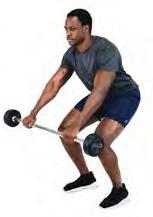
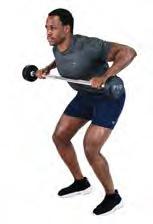




•
• Keep your heart rate elevated.
• Be cautious to add too many extra exercises to the training plan (you do not want to over-train).

• Start to implement more intense cardio exercises on your walk, jog or cardio day to ensure maximum results.
• Challenge yourself to see if you can follow your training and eating plan without deviating once for a week.



